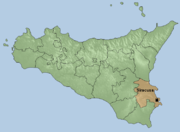
Roman Catholic Archdiocese of Siracusa
Encyclopedia


Sicily
Sicily is a region of Italy, and is the largest island in the Mediterranean Sea. Along with the surrounding minor islands, it constitutes an autonomous region of Italy, the Regione Autonoma Siciliana Sicily has a rich and unique culture, especially with regard to the arts, music, literature,...
. It became an archdiocese in 1744.
The current Archbishop is Salvatore Pappalardo. He will be given the pallium by Pope Benedict in June 2009, during a Mass on the feast of the Solemnity of the Holy Apostles Saints Peter and Paul.
History
Syracuse claimed to be the second Church founded by St. Peter, after that of AntiochAntioch
Antioch on the Orontes was an ancient city on the eastern side of the Orontes River. It is near the modern city of Antakya, Turkey.Founded near the end of the 4th century BC by Seleucus I Nicator, one of Alexander the Great's generals, Antioch eventually rivaled Alexandria as the chief city of the...
. It also claims that St. Paul preached there. As its first bishop it venerates St. Marcianus, whose dates are uncertain. Little authenticity can be assigned to the list of the seventeen bishops who were predecessors of Chrestus, to whom the Emperor Constantine wrote a letter.
In the times of St. Cyprian (mid-3rd century), Christianity certainly flourished at Syracuse, and the catacombs
Catacombs
Catacombs, human-made subterranean passageways for religious practice. Any chamber used as a burial place can be described as a catacomb, although the word is most commonly associated with the Roman empire...
located there attest to Christian worship there in the 2nd century. Besides its martyred bishops, Syracuse claims other Christian martyrs, such as St. Benignus and St. Eugarius (204), St. Bassianus (270); and the martyrdom of the deacon Euplus and the virgin St. Lucy under Diocletian
Diocletian
Diocletian |latinized]] upon his accession to Diocletian . c. 22 December 244 – 3 December 311), was a Roman Emperor from 284 to 305....
are thought to be historical.
The names of the known bishops of the following century are few in number: Germanus (346); Eulalius (465); Agatho (553), during whose rule Pope Vigilius
Pope Vigilius
Pope Vigilius reigned as pope from 537 to 555, is considered the first pope of the Byzantine Papacy.-Early life:He belonged to a aristocratic Roman family; his father Johannes is identified as a consul in the Liber pontificalis, having received that title from the emperor...
died at Syracuse; Maximianus and Joannes (586), who received letters from Pope Gregory I
Pope Gregory I
Pope Gregory I , better known in English as Gregory the Great, was pope from 3 September 590 until his death...
; while another bishop was denounced by Pope Honorius
Pope Honorius
Pope Honorius could refer to:#Pope Honorius I#*Antipope Honorius II#Pope Honorius II#Pope Honorius III#Pope Honorius IV...
for the protection which he accorded to prostitutes; St. Zozimus (640), who founded the monastery of Santa Lucia fuori-le-mura; St. Elias (d. 660).
Of Marcianos II it is said that he was consecrated not at Rome, but at Syracuse, since the Emperor Leo the Isaurian (726) had removed Southern Italy from the jurisdiction of Rome, and had then elevated Syracuse to the dignity of a metropolitan see, over the thirteen other dioceses of Sicily. Stephen II (768) carried to Constantinople the relics of St. Lucy for safety against the Saracen incursions.
Archbishop Gregorios Asbestas (about 845) was deposed by St. Ignatius, Patriarch of Constantinople
Patriarch of Constantinople
The Ecumenical Patriarch is the Archbishop of Constantinople – New Rome – ranking as primus inter pares in the Eastern Orthodox communion, which is seen by followers as the One, Holy, Catholic, and Apostolic Church....
, and then became the principal accomplice
Accomplice
At law, an accomplice is a person who actively participates in the commission of a crime, even though they take no part in the actual criminal offense. For example, in a bank robbery, the person who points the gun at the teller and asks for the money is guilty of armed robbery...
of the schismatic Patriarch St. Photius. In 878 St. Sophronius, together with the monk Theodosius, was thrown into prison at Palermo where he died in a dungeon. Until the Norman Conquest the names of further bishops are not known.
The series reopens in 1093 with Bishop Rober, who received the pallium from Urban II; in 1169 the Englishman Richard Palmer
Richard Palmer, Archbishop of Messina
Richard Palmer, an Englishman, was the bishop of Syracuse from 1169 and archbishop of Messina from 1182. Palmer first rose to prominence in 1160 as one of the triumvirate of grandees who replaced the assassinated Emir Maio of Bari...
was also invested by papal authority. In 1188 the see became suffragan of the archdiocese of Monreale. Among the bishops of this period are:
- Rinaldo de Lusio, killed in 1154;
- Pietro de Moncada (1313) and Ruggero Bellomo (1419), who restored the cathedral;
- Jacopo Venerio (1460), afterwards cardinal;
- Pietro de Urries (1516), ambassador of Emperor Charles V to the Fifth Lateran Council;
- Gerolamo Bononi (1541), a reformer at the Council of TrentCouncil of TrentThe Council of Trent was the 16th-century Ecumenical Council of the Roman Catholic Church. It is considered to be one of the Church's most important councils. It convened in Trent between December 13, 1545, and December 4, 1563 in twenty-five sessions for three periods...
; - Jacopo Orozco (1562), who introduced the Roman ritual in place of the Gallican, and who founded the seminary.
- Annibale Termini (1695).
In 1816 the diocese of Caltagirone was detached from Syracuse. The diocese of Piazza Armerina and diocese of Noto were made its suffragan sees, but the latter was detached in the same year.

